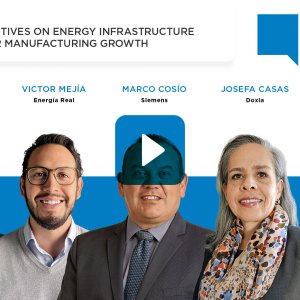Financing Schemes Dependent on the Energy Reform

Q: How did the initial stages of the Energy Reform influence your activities in financing renewable energy projects?
A: We had several meetings with solar developers in 2014 to move these projects forward, but we were unable to establish them. This is mainly due to the fact that when the Energy Reform was presented, the procedures to finance renewables were unclear and on top of that we were unsure how CENACE would buy the energy generated by renewable sources. Since these processes are yet unclear, we are unable to establish the appropriate financing conditions for these projects. On the other hand, the Energy Reform mandates that projects approved before its publication can be developed under the previous regulations, allowing us to finance these projects under the self-sufficient and self-supply schemes. Despite this turmoil, we are financing some small hydroelectric projects and we are currently analyzing a wind project under the previous scheme, and these projects are advancing as expected. As the dust settles, Banobras will revise the new initiatives to ensure they comply with the rules that will be established with the Energy Reform.
Q: In terms of the challenges faced by the Energy Reform, what are some of the remaining gray areas that lead to uncertainty?
A: Under the former regulations, both a permit and a PPA were needed, and both processes were simultaneous. This results in a problem for investors because now they might be unwilling to sign a contract for the long-term purchase of energy if the market conditions are likely to change. In my opinion this is the heart of the discussion, but another mayor problem is pricing. The Energy Reform states that renewable energy will be sold based on market conditions, meaning that the market will determine the price and investors will have to risk uncertainty. This is problematic for us, since Banobras’ methodologies are based on project finance tools. The previous PPA model had an established and well-known price for the energy produced.
Another important gray area that is crucial in the new regulations is the clean energy certificates, since the guidelines for their use are still hazy. At this stage, we want to know how they will be exchanged and whether it will be mandatory for big producers to purchase them. When the regulatory framework for the purchase of clean energy certificates is established, Banobras will still have to thoroughly analyze how the market responds to them and how to incorporate them in its finance schemes. Q: What are the main factors that make projects in the natural gas sector attractive for Banobras? A: There are three main reasons that make natural gas pipeline projects feasible for us to finance. The first is that the off-taker is either PEMEX or CFE, so as financers we are assuming the risk from these organizations. The second is that, in most cases, the consortium that wins the bid and the company that is tasked with building the project are not the same entity, so is important to clarify construction risks as the penalties are to be paid by construction companies. The third is that we are already familiar with natural gas projects, so are aware of the risks they present, such as rights of way arguments. Being aware of potential problems is advantageous for us because we can propose potential solutions. There are companies experienced in several of these issues in other markets but this is still a new area, so future problems cannot be fully determined. Another important point is that these are take-or-pay projects, which means that payment is subject to availability criteria.
Q: Is Banobras concerned about PEMEX’s credit rating now that the company will seek profit and value creation?
A: That is a question that our credit committee has asked itself over the past few months. It is not possible for us to analyze PEMEX the way that we used to because the conditions have changed considerably. Now it is a productive enterprise of the State, and the risk levels will invariably increase because anything that happens to this company will impact the entire Mexican economy. However, we are certain that PEMEX will continue to be a large and powerful company connected to the main branches of the economy. We will have to be careful when assessing the risks, but we do not believe they will greatly increase from one year to the next. We feel that we can handle these risks and if PEMEX needs financing support, we can provide reinforcement.



















